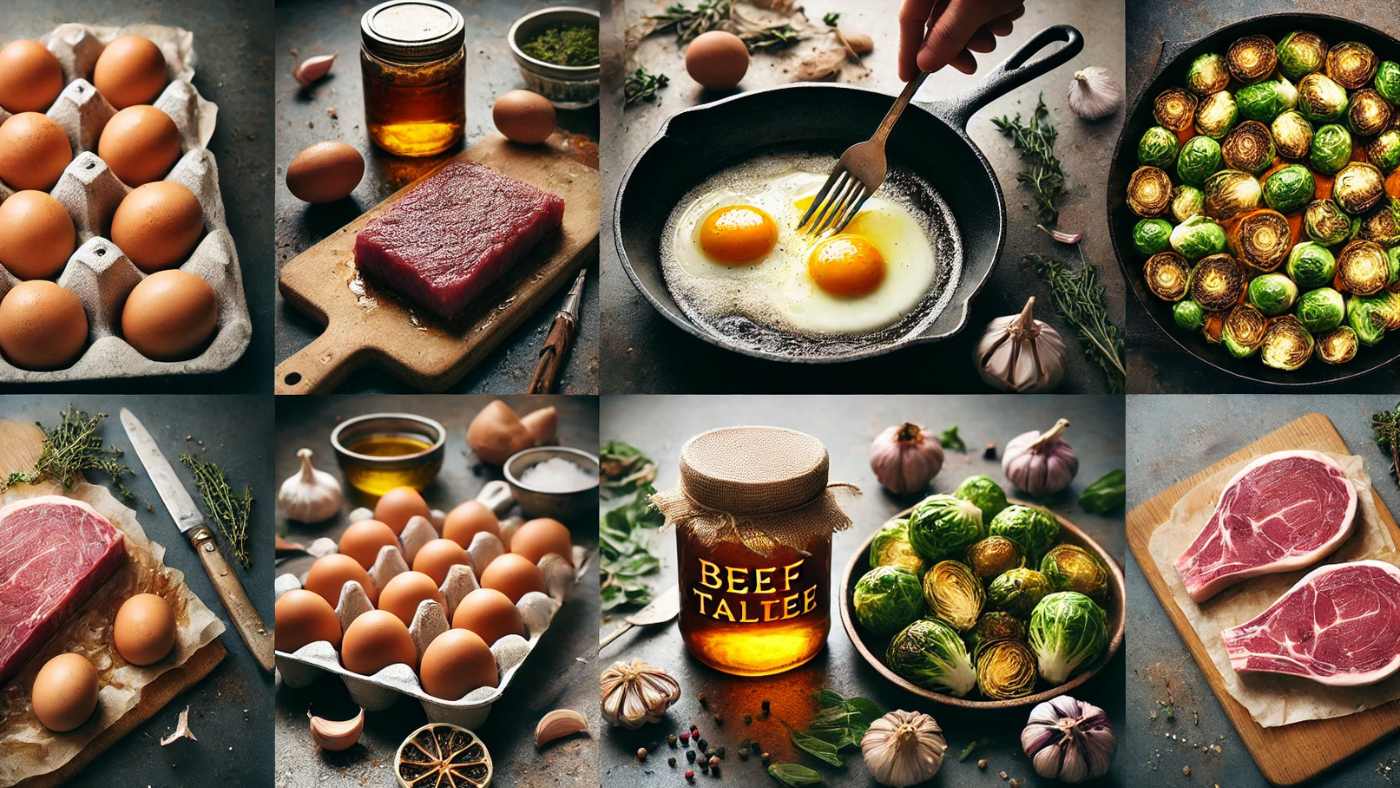How to Use Beef Tallow in Cooking: Best Tips & Health Benefits

For a good reason, beef tallow is becoming increasingly popular in kitchens.
Since ancient times, people have utilized this adaptable, nutrient-dense fat to enhance various foods' taste, texture, and health advantages.
If you're wondering how to use beef fat in cooking, you're in the right place.
From frying and roasting to baking, beef tallow is a game-changer for any home cook.
Not only does it bring out the best in your food, but it’s also a healthier alternative to many common cooking oils.
Let’s explore why beef tallow should be a staple in your kitchen and the best ways to use it.
What is beef tallow?
Beef tallow is rendered fat from beef, primarily sourced from the fatty tissues of cows.
It's a solid fat at room temperature but melts into a golden liquid when heated.
Historically, it was a primary cooking fat before the rise of vegetable oils and margarine.
People also used it for candle making, soap production, and skincare.
Unlike processed oils, beef tallow is a natural fat consumed for generations.
Its rich flavor, high smoke point, and capacity to improve food texture make it highly valued.
Health Benefits of Using Beef Tallow
There are several health advantages to using beef fat in cooking, particularly when contrasted with processed oils.
It’s rich in saturated fats that support cellular function and help maintain healthy cholesterol levels (1).
Tallow contains conjugated linoleic acid (CLA), which is linked to reducing inflammation and improving body composition (2).
Beef tallow is also a great source of omega-3 fatty acids, suitable for the heart and brain, especially when cows are given grass (3).
Unlike refined vegetable oils, beef fat has a high smoke point—around 400°F (204°C) (4).
This makes it a safer option for high-heat cooking because it won’t break down into harmful compounds.
Since it’s free from artificial additives and highly processed ingredients, it’s a more natural and holistic choice for your kitchen.
Best Ways to Use Beef Tallow in Cooking
Beef tallow is incredibly versatile, making it perfect for various cooking techniques.
Here are a few of the most effective uses for it:
Frying and Sautéing: Beef tallow is ideal for frying and sautéing. It gives food a crispy, golden finish while imparting a subtle richness. To enhance the natural flavors of veggies, pork chops, or poultry, try frying them in beef tallow.
Roasting Vegetables: If you love crispy, roasted vegetables, beef tallow is a must-try. Coat your veggies in melted tallow before roasting, and they’ll come out with a beautifully crisp texture. Toss some Brussels sprouts, potatoes, or carrots in beef tallow for a tasty side dish, season with herbs, and bake.
Pan-Seared Meats: For juicy, perfectly seared steaks or chicken, beef tallow is hard to beat. Heat a spoonful of tallow in your skillet before searing. The fat helps lock in moisture and flavor, giving your meat a restaurant-quality finish.
Making Homemade Fries: There’s nothing like homemade fries cooked in beef tallow. The high smoke point makes it perfect for deep frying. Cut your potatoes, heat the tallow in a deep pan or fryer, and fry until golden brown for irresistibly crispy fries.
Baking with Beef Tallow: Beef tallow can also be used in baking as a substitute for butter or shortening in savory recipes. Try using it in pie crusts or biscuits to add a unique flavor and flakiness that other fats can’t provide.

How to Store and Reuse Beef Tallow
One of the best things about beef tallow is that it’s easy to store and reuse.
Your beef tallow should be stored in an airtight container in a cold, dry location.
It can also be refrigerated for several months or frozen for extended periods.
When storing in the fridge, simply let it soften at room temperature before using.
Beef tallow can be reused multiple times if you filter it after each use.
After frying or cooking, strain the tallow through a fine mesh to remove any food particles.
As long as the tallow is clear and smells fresh, it’s ready for the next round of cooking.
Is beef tallow healthier than butter?
Many people wonder whether beef tallow is healthier than butter; the answer depends on your dietary needs and preferences.
While each type of fat has advantages, beef tallow has certain unique advantages.
Because butter has a lower smoke point than beef tallow, it might deteriorate at high temperatures even though it is loaded with vitamins A, D, and K.
Conversely, turkey has a more stable structure when heated, making it ideal for frying and roasting.
Beef tallow also contains more Omega-3 fatty acids and CLA, especially when it’s grass-fed (5).
Because of this, turkey is a preferred choice for people who want to consume more beneficial fats.
Both tallow and butter can be part of a healthy diet for everyday use, but tallow shines in high-heat applications.
How to Make Beef Tallow at Home
Making your beef tallow at home is simple and cost-effective.
Here’s a quick guide:
- Source quality beef fat from your butcher or grocery store. Grass-fed beef fat is preferable for the best nutritional profile.
- Cut the fat into small chunks or grind it for faster rendering.
- Place the fat in a slow cooker or large pot and heat on low to melt and render it slowly.
- After straining the liquid fat through cheesecloth or a fine mesh screen, pour it into a clean jar.
- Let it cool to room temperature and solidify.
Once solidified, your homemade tallow is ready to use!

Recipes That Use Beef Tallow
Now that you know how to use beef tallow in cooking, here are some simple recipes to get you started:
Crispy Tallow-Roasted Potatoes: Toss quartered potatoes in melted beef tallow, season with salt and herbs, and roast at 425°F for 40 minutes.
Pan-seared steak with tallow: heat a tablespoon of beef tallow in a cast-iron skillet. Sear your steak on high heat for 3 minutes on each side, then finish in the oven for a perfectly cooked steak.
Beef Tallow Biscuits: Substitute tallow for butter in your favorite biscuit recipe for a savory twist. The tallow adds a flaky texture and a rich, beefy flavor that pairs well with soups and stews.
Final Thoughts
Beef tallow is more than just a trendy cooking fat.
It’s a return to a natural, time-tested way of cooking that brings out the best in your food.
It enhances the flavor and crispiness of your food in addition to providing a host of health advantages.
If you haven’t tried cooking with beef tallow, now is the time.
Wild Foods offers high-quality, sustainably sourced beef tallow, perfect for taking your meals to the next level.
🌿 Upgrade your diet with versatile, sustainable beef tallow. Start now! 💪
FAQs
What is the best way to use beef tallow in cooking?
The best way to use beef tallow is in high-heat cooking like frying, roasting, and sautéing, where its high smoke point ensures optimal results.
Is beef tallow safe to cook with?
Indeed, beef tallow is a natural, stable fat that resists breaking down under high heat and is safe for cooking.
Can I substitute beef tallow for butter in baking?
Beef tallow can indeed be used in place of butter in savory baked items such as pie crusts and biscuits.
How does beef tallow compare to other cooking oils?
Compared to vegetable oils, beef tallow is more stable at high temperatures and free of processed additives, making it a healthier option for cooking.
Can I fry eggs in beef tallow?
Indeed, frying eggs with beef tallow produces crispy edges and a deeper taste than in butter or vegetable oils.
Related Studies
1. Title: The effects of saturated fat intake from dairy on CVD markers
This study discusses how saturated fat intake from dairy products influences cholesterol levels, suggesting that larger LDL particles may be less harmful than smaller ones.
Link: https://www.cambridge.org/core/journals/proceedings-of-the-nutrition-society/article/effects-of-saturated-fat-intake-from-dairy-on-cvd-markers-the-role-of-food-matrices/3798DD6D40F1E0AC4FC99B16B0A29BA6
2. Title: The effects of conjugated linoleic acid supplementation on inflammatory cytokines and adipokines: A systematic review and meta-analysis
This meta-analysis evaluates the impact of CLA supplementation on inflammatory markers, revealing its potential to reduce TNF-α and IL-6 levels while increasing CRP levels.
Link: https://www.frontiersin.org/journals/immunology/articles/10.3389/fimmu.2023.1092077/full
3. Title: Dietary saturated fat and cholesterol: cracking the myths around eggs
This comprehensive review examines the complexities of cholesterol metabolism, highlighting that saturated fats can increase LDL cholesterol but may also lead to larger, less atherogenic LDL particles.
Link: https://pmc.ncbi.nlm.nih.gov/articles/PMC10495817/
4. Title: Smoke Points: A Crucial Factor in Cooking Oil Selection for Public Health
This review emphasizes the importance of smoke points in cooking oils, detailing how fats with higher smoke points, like beef tallow, produce fewer harmful compounds when heated.
Link: https://www.eurekaselect.com/article/136504
5. Title: Grass-Fed Beef: Is It Good for You?
This article outlines the nutritional advantages of grass-fed beef, noting it contains significantly higher levels of omega-3 fatty acids compared to grain-fed beef, which benefits heart and brain health.
Link: https://www.webmd.com/diet/grass-fed-beef-good-for-you

